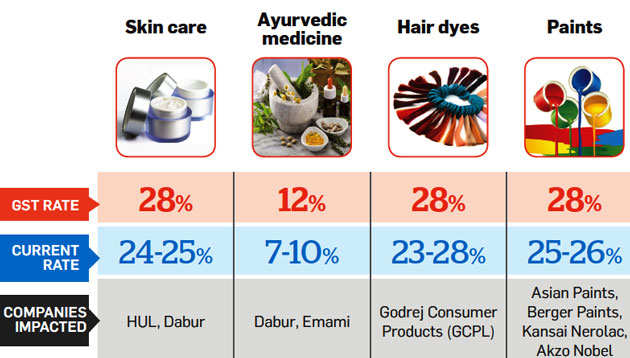The new Goods and Services Tax (GST) regime will bring several benefits
for the economy, and could particularly vitalise the fast-moving
consumer goods (FMCG) industry.
Apart from driving supply
chain efficiencies, bringing untaxed players into the tax net—a large
section of the industry still operates in the unorganised segment— will
level the playing field for the larger, established players in the
industry.
However, the GST rate structure shows that not all FMCG companies stand to benefit from the new regime.
Products to be taxed at higher rate

GST beneficiaries
The rates for various FMCG segments have mostly been along expected
lines. Items of mass consumption—toothpaste, soaps, hair oil—have been
put under the 18% tax slab, significantly lower than the 22-24% tax rate
they have been paying. This is in accordance with the government’s
stance of keeping tax rates low for mass consumption products. In fact,
the GST rate schedule indicates that nearly 81% of all items are in the
18% tax bracket or below. The remaining 19% fall in the 28% tax slab.
Products to be taxed at lower rate

The FMCG companies, whose tax incidence
has come down under the GST regime, are likely to pass it on to the
consumers in the form of lower prices. "With the anti-profiteering
clause in place, companies would be required to pass on the benefit of
tax rates to the consumer in the form of lower prices," says Sanjay
Manyal, Analyst, ICICI Securities.
Lower prices could
potentially support volume growth for certain products, particularly in
the rural segment. "We believe it could result in a faster consumption
shift from unbranded to branded products, spurring volume growth for
FMCG companies. Simultaneously, it will also bring operational
efficiency with rationalisation of supply chain by removing
bottlenecks," says Manyal. Analysts also point out that tax exemption
provided to several critical products required for food
processing—jaggery, cereals and milk— would benefit this industry.
So, which are the companies that stand to gain from a benign tax
regime? The extent of impact would depend on the product mix of the
companies. Oral care major Colgate Palmolive is likely to emerge as the
biggest beneficiary. "Colgate pays an effective tax of 25-26%. The new
18% tax on toothpastes (make up 80% of the company’s sales) is a
positive, particularly as it levels the playing field against Dabur and
Patanjali, who enjoy tax benefits," says a Motilal Oswal report. Hair
and edible oil companies too will benefit. "Marginally lower rates in
hair oil with no increase in edible oil rates will benefit Marico," says
an Axis Capital report.
Adversely impacted firms
Surprisingly, some of the widely consumed products have been placed
under the highest tax slab of 28%—slightly higher than the rate levied
earlier. "Higher tax rate in paints and possibly baby food will
marginally impact Asian Paints and Nestle," says the Axis Capital
report. Higher tax rate for detergents and shampoo is a real dampener
since these are daily-use, mass consumption items. Manufacturers will
have to pass on the higher tax incidence to consumers in the form of
higher prices of these goods.
However, it will not have
much impact on the sale volumes, say analysts. Most of the items
belonging to the premium category have been put under the highest tax
slab of 28%. These include health supplements, skin care, aerated
drinks, liquid soap, among other goods. But this is not going to have a
particularly negative impact on manufacturers as they had been paying
similar taxes earlier. The increase, in some cases, is only marginal.
However, the firms who were focusing on premiumisation of their product mix to drive profitability,
could be hurt because of the higher taxes. These firms may have to
rethink strategy and realign their portfolio. Ayurvedic products—a
segment that is seeing increased focus from leading FMCG players—are to
be taxed at 12%, slightly higher than the prevailing rate. This may hurt
Dabur, which has a wide portfolio of ayurvedic products. Emami too
could come under pressure. Ayurvedic players were expecting the tax rate
to go down, given the government’s thrust on popularising traditional
Indian medicine.
For most other FMCG majors, the GST rate
structure is likely to be neutral or marginally positive, as their broad
portfolios would see a mixed impact. In case of HUL, for instance, tax
incidence has reduced for soap, toothpaste and tea, but increased for
detergent, shampoo and skin care. For Godrej Consumer Products, lower
tax incidence on soaps and insecticides is a positive, but higher tax
rate for hair dye is a negative.
29 May 2017, 08:41 AM